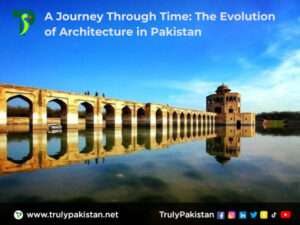Ancient Marvels – Indus Valley Civilization:
Our journey commences with the ancient wonders of the Indus Valley Civilization, which thrived from approximately 3300 BCE to 1300 BCE. This civilization predates Mesopotamia and Egypt, showcasing advanced urban planning and engineering. The cities of Mohenjo-Daro and Harappa exemplify meticulous urban design with grid-pattern streets, a hydraulic engineering masterpiece in the form of the Great Bath, and multi-story houses with private bathrooms and drainage systems. Yet, the undeciphered script of this civilization adds an air of mystery to its architectural legacy.
The Fusion of Buddhism and Gandhara:
Moving forward in time, we delve into the Gandhara region, influenced by Buddhism from the 1st to the 5th century CE. This era witnessed the fusion of Hellenistic and Indian architectural elements, creating the unique Gandhara art style. The region, spanning modern-day Pakistan and Afghanistan, blended Western and Eastern artistic traditions. The Buddhist monastic complex at Takht-i-Bahi, a UNESCO World Heritage Site, stands as an epitome of Gandhara architecture with intricately carved Buddha statues and a captivating architectural layout.
Mughal Magnificence:
The pinnacle of architectural magnificence in Pakistan was unequivocally attained during the Mughal era, which extended from the 16th to the 19th centuries. The Badshahi Mosque in Lahore, a commission by Emperor Aurangzeb, stands as a testament to the opulence of Mughal architecture. Concluded in 1673, it stands among the world’s most colossal mosques, epitomizing exquisite artisanship. Its red sandstone and white marble façade are adorned with intricate calligraphy and geometric patterns, showcasing a remarkable dedication to detail. Adjacent to the mosque, the Lahore Fort, a UNESCO World Heritage Site, houses the Sheesh Mahal, or Palace of Mirrors, an architectural marvel with walls adorned with reflective glass pieces.
Colonial Era and British Influence:
The 19th century brought British colonial influence, transforming Pakistan’s architecture. Notably, Lahore became a canvas for the fusion of Western architectural styles with indigenous elements. The Lahore High Court, completed in 1849, is a splendid example of British colonial architecture, reflecting the Victorian Gothic Revival style. Meanwhile, Karachi’s economic significance during the colonial era led to iconic structures like the Karachi Port Trust Building, completed in 1915, boasting a distinctive clock tower and Victorian aesthetics.


Post-Independence Modernization:
In 1947, Pakistan’s post-independence period marked a significant shift, with architecture serving as a medium for nation-building efforts. The State Bank of Pakistan building in Karachi, designed by architect Habib Fida Ali, exemplifies modernist influences with clean lines and a minimalist aesthetic, symbolizing the nation’s forward-looking ideals. The 1960s and 1970s saw a wave of modernization projects, particularly in Islamabad, the newly designated capital, characterized by a grid layout and modern amenities.
Contemporary Architecture and Sustainable Trends: In the 21st century, Pakistani architecture finds itself at the intersection of tradition and modernity. Architects grapple with the challenge of preserving cultural heritage while embracing contemporary design. The Aga Khan Cultural Centre in Islamabad, designed by Pritzker Prize-winning architect Fumihiko Maki, strikingly balances modernist design with traditional elements, embodying the ongoing dialogue between the past and present in Pakistani architecture.
Contemporary architects are also pioneers of innovative solutions addressing urbanization and sustainability, emphasizing green architecture for energy efficiency and ecological sustainability. The integration of smart building systems is revolutionizing architectural design and operation.
Preserving Traditional Crafts and Materials:
Rural architecture in Pakistan remains a vital part of the nation’s built environment. Traditional vernacular architecture, adapted to local climates and materials, continues to inspire architects seeking sustainable, contextually relevant solutions. There is a revival of traditional crafts and materials in various regions, preserving cultural heritage and providing sustainable economic avenues for local communities.
Conclusion:
As we conclude this architectural odyssey through Pakistan’s history, we understand that architecture is more than just a physical expression; it is a narrative reflecting the collective identity and aspirations of a nation. The architectural evolution in Pakistan mirrors its intricate history, where diverse influences have converged and diverged.
By preserving this architectural heritage, Pakistan ensures that its story, told through arches, domes, columns, and courtyards, continues to resonate through the ages. The ongoing dialogue between tradition and modernity signifies not just architectural evolution but a cultural continuum that shapes the nation’s identity.
As Pakistan moves forward, architects, preservationists, and policymakers are entrusted with the responsibility of balancing progress with heritage and innovation with tradition. This architectural journey is not a mere retrospective exploration but an ongoing narrative, inviting architects, historians, and enthusiasts to be a part of its unfolding story.
In the stones and arches, Pakistan’s architectural journey represents a timeless dance between the echoes of the past and the aspirations of the future. It beckons us to explore, appreciate, and contribute to the ever-evolving saga of a nation’s built heritage.

